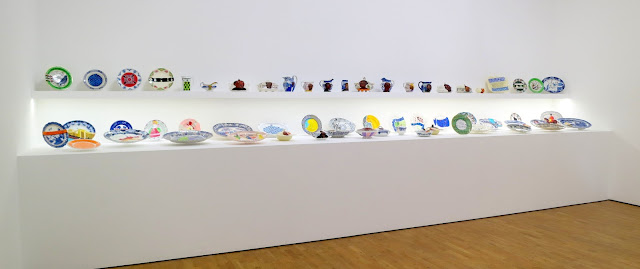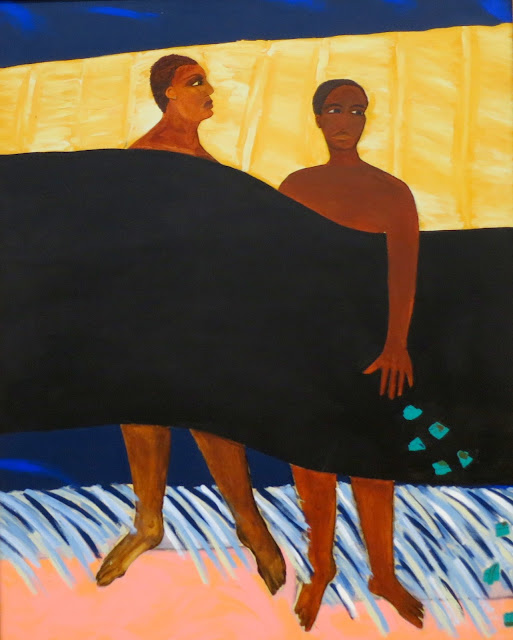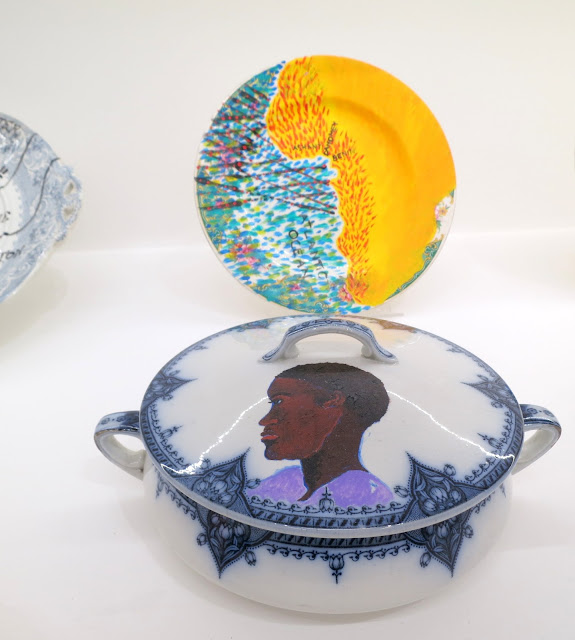'It would seem to me that museums contrive to do a great disservice to Black People. These palaces of culture are charnel houses full of stolen goods, where the treasures of Black heritage and creativity are hoarded, neglected and ultimately wasted... Until the stolen goods are returned and until we take the space to chronicle our own experience as we find it, to honour those who have gone before and encourage our children, there will be nothing great, honourable, honest or decent about the Museum'.
Invisible Strategies, Lubaina Himid,

at Modern Art, Oxford.
'I am not a painter in the strictest sense... I am a political strategist who uses a visual language to encourage conversation, argument, change'.

Hamid is one of the pioneers of the British Black Arts Movement that emerged in the early 1980s. Across a thirty-year career, she has strived to make visible the forgotten black subjects of our collective history. She uses her work to raise important issues with her audience.
'The point I am often exploring vis-à-vis the black experience is that of being so very visible and different in the white Western everyday yet so very invisible and disregarded in the cultural, historical, political or economic record of history'. Her work calls for recognition of the centuries-long contribution of people from the African diaspora to Western culture. Her project recovers neglected histories and overlooked material cultures: erased communities and their stories are given voice through objects, texts and images. She seeks to acknowledge, value and commemorate the many unnamed, unrecorded individuals who were victims of the transatlantic slave trade and asks us to view this painful history in light of present day conditions. She negotiates appropriation, storytelling, abstraction and influence by employing the principles of montage, over-painting and juxtaposition.
Zanzibar - Sea: Wave Goodbye Say Hello, 1999, (acrylic paint on canvas)
Freedom and Change, 2016, (acrylic on canvas)
The Source of the Tears is Long Run Dry, 2016, (acrylic on canvas)
Freedom and Change, 1984, (plywood, fabric, mixed media, acrylic paint)
In this early work Himid appropriates the female figures from Pablo Picasso's Two Women Running on the Beach (The Race) (1922), which became the design for the drop curtain of the Ballets Russes production of Le Train Blue in 1924, and depicts them as black women, elegantly and humorously subverting a work of 20th century European painting, to suggest alternate perspectives and protagonists. The materials of Freedom and Change are those used for theatrical stage scenery, and as the artist has explained: 'I trained as a theatre designer and have always been interested in how performance can be an agent for political change.
looking closer
looking closer
Le Rodeur (The Lock), 2016, (acrylic on canvas)
Le Rodeur (Exchange), 2016, (acrylic on canvas)
Fishing, 1987, (acrylic on canvas)
Carpet, 1992, (acrylic on canvas)
Carpet combines allusions to the abstract forms and colours of European modernism (the paintings of Henri Matisse in particular) with references to the global production and trade of textiles and fabrics.
Five, 1991, (acrylic on canvas)
'Two women sit at dinner forming strategy; can the future be different, better', is how Himid describes the scene. Egyptian flowers stand tall in a vase; the women's plates depict the map of Africa and fragments of African flags. These symbols sit within an early 20th century setting of the Parisian bistro, a modern space of debate and exchange. The art historian Griselda Pollock emphasises that the 'space in Five is not closed off to the viewer. Others may pull up a chair... The two women's gestures signify engagement, argument, conversation, discussion'. For Himid, these characters take action in response to their experiences of oppression, not through violence but by continuing to survive and by making possible new conversations.
Ankledeep (from the series Revenge), 1991, (acrylic on canvas)
In this painting, as described by the art historian Dorothy Price, we witness 'two black women seeking their revenge from the fabric of history. The women shred and scatter the colonial maps of the past before searching for new robes and debating new directions'. Maps are how the world is organised: whoever controls the maps, retains the power over that land. Maps can be understood as symbols of colonial conquering powers, destroying and controlling territories and knowledge. To tear up a map is to unravel a set of historical narratives and power structures. Discarding their own garments, the women in Ankledeep set off on a new course.
Unwrapped but not Untied (from the series Revenge), 1991, (acrylic on canvas)
Bone in the China: Success to the African Trade, 1985, (acrylic on wood with aluminium, and acrylic on canvas)
The Glare of the Sun, 1999, (acrylic on canvas)

Swallow Hard: The Lancaster Dinner Service, 2007
During 2007 the Lancashire Museums commissioned Himid to produce an installation at the Judges' Lodgings. The installation is her response to Lancaster's involvement in the slave trade and the legacy that was left in the city. She created a 100 piece dinner service to adorn the dinner table. She sought out ceramic pieces from Lancaster and Whitehaven, adding her own layers of decoration. There were images of buildings, traders, ships, slaves/servants, families, plants, maps and goods such as mahogany connected with the establishment, development and subsequent abolition of the slave trade.
'The Lancaster Dinner Service is an intervention, a mapping and an excavation. It is a fragile monument to an invisible engine working for nothing in an amazingly greedy machine. It remembers slave servants, sugary food, mahogany furniture, greedy families, tobacco and cotton fabrics but then mixes them with British wild flowers, elegant architecture and African patterns...
Overpainting has become central to my work at the moment. In the past I have painted over maps, museum postcards and pages from magazines'.
'Inside the tureens and jugs are the names of the people painted on the outside; a hidden but very real identity'.






























Dear Eirene,
ReplyDeleteI'm very pleased with your blog.
This one is great special the ceramic-pic's.
Love,
Ruud Mooijman, Amsterdam
Thank you for your kind words Ruud. I am glad you like the blog. By the way, Amsterdam is one of my favourite cities. Take care and all the best.
ReplyDelete